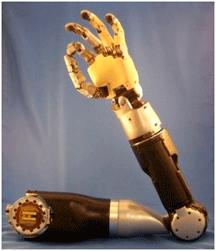Micro Waterjet (MWJ) helps HDT Engineering Services produce components for a revolutionary new prosthetic arm

A number of components for this MPL are being designed and produced by HDT Engineering Systems with the help of micro manufacturing afforded with the microwaterjet® manufacturing system.
We sat down with Ezra Johnson, Manager of Systems Engineering, HDT Engineering Services, Inc., to discuss the program and how the microwaterjet® manufacturing system helped them achieve their goals.
MWJ: What made you choose Micro Waterjet technology instead of other available processes?
Ezra: For metallic parts, the cost of producing parts using the Micro Waterjet cutting system is less than wire EDM and we were able to hold to tight tolerances. In the past we were using punching for thinner parts and we had to make a tool for each part. As an engineering firm, our parts are often manufactured, tested, slightly modified and then manufactured again. So, each time a design changed for parts which will ultimately be made by punching, new tools had to be made. This was time consuming and costly, but with Micro Waterjet cutting process we can have modified parts manufactured simply by sending them a new design file. Changes are now fast and cost-effective and the Micro Waterjet cut parts are more precise than punching.
We have also used lasers in the past for smaller, critical parts but some materials have compatibility issues since the laser tends to burn thinner materials. But, with the Micro Waterjet process we have no issues with burning or heat effected zones.
MWJ: What advantages do you feel the Micro Waterjet process has over conventional processes?
Ezra: The biggest advantage we have found with micro waterjet cutting is material compatibility as compared to laser or Wire EDM. The micro waterjet system can cut a wider range of materials with a very high degree of precision. Also, the cost of producing prototype parts is less with the micro waterjet process when compared to punching or wire EDM.
MWJ: How has it been working with Micro Waterjet?
Ezra: HDT has listed Micro Waterjet into our preferred database and they have a 4 star rating in every category. Additionally, Micro Waterjet’s pricing is fair and consistent. Unlike other suppliers who have raised their prices when they are busy and then lowered them again when they are slow, we have never had an issue with Micro Waterjet in this regard. Micro Waterjet’s consistency and accuracy are dependable. So far, their parts have never been out of spec and we are happy to report that we have never had to send a part back for any reason. Micro Waterjet has been very responsive. They respond quickly to our pricing requests, purchase orders and overall correspondence and I am pleased to say that they deliver on time.
If you would like to learn more about the Modular Prosthetic Limb (MPL) system, you can check out these articles on the internet. Click on the links below to read the full articles.
DARPA-funded prosthetic arm reaches phase three, would-be cyborgs celebrate
Hopkins Applied Physics Lab Awarded DARPA Funding to Test Thought-Controlled Prosthetic Limb System
DARPA-funded prosthetic arm reaches proviso 3, would-be cyborgs applaud
